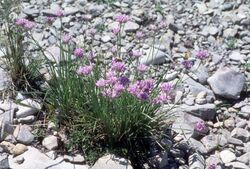Biology:Allium geyeri
| Geyer's onion | |
|---|---|

| |
| Scientific classification | |
| Kingdom: | Plantae |
| Clade: | Tracheophytes |
| Clade: | Angiosperms |
| Clade: | Monocots |
| Order: | Asparagales |
| Family: | Amaryllidaceae |
| Subfamily: | Allioideae |
| Genus: | Allium |
| Subgenus: | A. subg. Amerallium |
| Species: | A. geyeri
|
| Binomial name | |
| Allium geyeri S.Wats.
| |
| Synonyms | |
| |
Allium geyeri or Geyer's Onion is a North American species of onion widespread in the western United States and in western Canada . It is found in the Rocky Mountain States from New Mexico to Idaho, Great Basin, the Pacific Northwest, Texas , South Dakota, Arizona, Manitoba, British Columbia, Alberta and Saskatchewan.[2][3]
Description
There are three varieties of the onion:
- Allium geyeri var. chatterleyi S.L.Welsh - Abajo Mountains in Utah[3][4]
- Allium geyeri var. geyeri - much of species range
- Allium geyeri var. tenerum M.E.Jones[5] - much of species range
Allium geyeri produces narrowly elongate bulbs up to 25 mm long. Flowering stalks can reach up to 50 cm in height. Flowers are bell-shaped to urn-shaped, pink to white with yellow pollen.[2][6][7][8][9]
Allium geyeri, like many alliums, is pollinated by many varieties of bumble bee. Known pollinators of this onion include the Bombus bifarius, Bombus centralis, Bombus flavifrons, Bombus huntii, Bombus melanopygus, Bombus sylvicola, Bombus occidentalis, and Bombus bohemicus.[10][11]
References
- ↑ Smith, K. (2016). "Allium geyeri". IUCN Red List of Threatened Species 2016: e.T64263485A67728493. doi:10.2305/IUCN.UK.2016-1.RLTS.T64263485A67728493.en. https://www.iucnredlist.org/species/64263485/67728493. Retrieved 11 November 2021.
- ↑ 2.0 2.1 Flora of North America, v 26 p 237, Allium geyeri
- ↑ 3.0 3.1 Welsh, Stanley Larson. 1993. Rhodora 95(883/884): 417–418 diagnosis in Latin, commentary and key in English
- ↑ Welsh, Stanley Larson. 1993. Rhodora 95(883/884): figure 23 line drawing of Allium geyeri var. chatterleyi
- ↑ Jones, Marcus Eugene. 1902. Contributions to Western Botany 10: 28, f. 55.
- ↑ Watson, Sereno. 1879. Proceedings of the American Academy of Arts and Sciences 14: 227–228.
- ↑ Hitchcock, C. H., A.J. Cronquist, F. M. Ownbey & J. W. Thompson. 1969. Vascular Cryptogams, Gymnosperms, and Monocotyledons. 1: 1–914. In C. L. Hitchcock Vascular Plants of the Pacific Northwest. University of Washington Press, Seattle.
- ↑ Cronquist, A.J., A. H. Holmgren, N. H. Holmgren & Reveal. 1977. Vascular Plants of the Intermountain West, U.S.A. 6: 1–584. In A.J. Cronquist, A. H. Holmgren, N. H. Holmgren, J. L. Reveal & P. K. Holmgren (eds.) Intermountain Flora. Hafner Pub. Co., New York.
- ↑ Moss, E. H. 1983. Flora of Alberta (ed. 2) i–xii, 1–687. University of Toronto Press, Toronto.
- ↑ Webmaster, David Ratz. "Geyer's Onion - Montana Field Guide" (in en). https://fieldguide.mt.gov/speciesDetail.aspx?elcode=PMLIL02100.
- ↑ Miller-Struttmann, Nicole E.; Galen, Candace (2014-09-09). "High-altitude multi-taskers: bumble bee food plant use broadens along an altitudinal productivity gradient". Oecologia 176 (4): 1033–1045. doi:10.1007/s00442-014-3066-8. ISSN 1432-1939. PMID 25199658. https://pubmed.ncbi.nlm.nih.gov/25199658/.
External links
- "Allium geyeri". http://www.pfaf.org/user/Plant.aspx?LatinName=Allium+geyeri.
- "Allium geyeri tenerum". http://www.pfaf.org/user/Plant.aspx?LatinName=Allium+geyeri+tenerum.
Wikidata ☰ Q5669357 entry
 |


